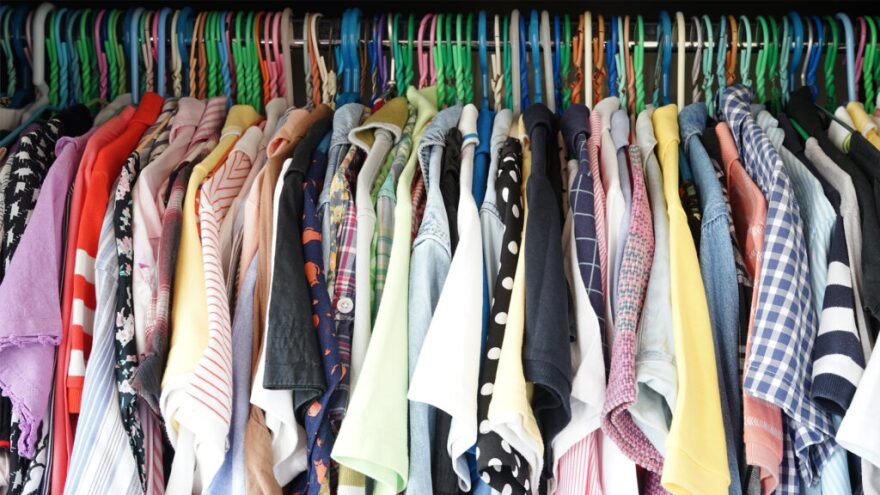Concerned about the environmental impact of fast fashion – trendy garments made quickly and cheaply – Orlando resident Wednesday Terry wanted to push back.
So, a year ago, she started her own slow fashion crochet business, Colored Entropy. The Florida native crochets colorful outfits and hats using only second hand or 100% cotton yarn.
Contrary to fast fashion’s output of quick-turn throwaway goods, her main goal is to produce longer-lasting attire to “reduce landfill waste and then also reduce microplastics” and give consumers an alternative to clothing that is rapidly produced in high quantities by underpaid workers.
“I really like the connection that handmade clothing brings,” Terry, 25, said. “I want to get people to understand the harms of fast fashion and care about their clothing more.”

Fast fashion carries a lower price tag for consumers, but the cost can be high for the environment.
Traditional fashion focuses on releasing quality lines of clothing for each of the traditional four seasons, while fast fashion has 52 “micro-seasons,” which equates to a new line of clothing each week, reports The Good Trade, a website focused on sustainable fashion. This speedier production process relies on synthetic fabrics made from plastic, which produces high levels of greenhouse gases, particularly carbon dioxide, that contribute to climate change.
Those cheaper-to-make, cheaper-to-buy items are discarded faster, generating additional waste in landfills around the world.
Gwenyth Diaz, a full-time Florida Atlantic University student and mortician, used to buy a lot of fast fashion due to its convenience and price. However, after realizing the environmental cost of fast fashion, Diaz became an advocate against it.
“If there’s one little thing I can do to help the environment, it would be being conscious of where I buy my clothes,” said Diaz, 24, a multimedia journalism major.
In its earliest stage, fast fashion relies heavily upon cheap synthetic fibers, such as polyester. Polyester is a plastic-like material made from oil, and it requires significant amounts of energy to produce, according to the Council of Fashion Designers of America. From drilling to chemical processing, polyester production generates high levels of greenhouse gases – 31.3 pounds per 2.2 pounds produced, the council says.
Fast fashion is “one of the biggest contributors to climate change and to global warming, because it’s a huge industry that takes over agriculture, takes over the livelihood of people, it takes over transportation, uses oil to produce polyester, so it’s an extended, pervasive industry,” said Francesca Belluomini, 55, a fashion sustainability educator in Miami.
The fast fashion industry is responsible for around 10% of global carbon dioxide emissions, according to the Center for Biological Diversity.
Even after the production stage and into the consumption stage, fast fashion can still contribute to pollution through microplastics — which are pieces of plastic around the size of a pencil eraser, according to the National Oceanic and Atmospheric Administration.
According to Jacqueline Salmond, a sustainability researcher in Fort Myers, laundering fast fashion clothing is a major local concern as it releases microplastics into drinking water and marine ecosystems. Just one clothing article can release 700,000 fibers in a single wash cycle, which then drains into local waterways, according to Greenpeace.
“I think they need to put some things in place to make this a necessity that people have filters on their laundry,” said Salmond, who currently teaches a course focused on sustainability and environmental justice for Florida Gulf Coast University. “It’s a relatively easy thing to do.”
Local landfills also receive discarded pieces of fast fashion that can threaten South Florida’s water systems, Salmond said. She said landfill microplastics can leak into the aquifer and contaminate Florida’s underground drinking water and pollute marine systems.
Fast fashion’s production process also exacts a toll on human workers.

In order to keep up with trends, meet mass-production demands and secure maximum profits, companies depend on sweatshop labor, often in developing countries, where people work long hours for little pay in unhealthy or dangerous work environments., according to a study published by the International Journal of Developmental Research.
Workers are often required to work 48-hour weeks for “poverty pay” in a dangerous working environment, according to the Clean Clothes Campaign. In Bangladesh, the average salary is 33 cents an hour, reports Earth.Org, an environmental news website. Child labor is also extremely common in these shops.
“There are an average of 60 hands that an item goes through from the time that it’s being designed to the time that it ends up in the racks at H&M,” Belluomini said. “And if you find something that is $5, but there has been an average of 60 hands, you understand that the $5 is impossible.”
Once fast fashion items are bought in the store, they often have a short lifespan in the hands of consumers. People only wear their clothes an average of seven to 10 times before throwing them away, Anthropocene Magazine reports.
“We used to have items of clothing and wear them 30 times before we discarded them, now it’s gone down,” Salmond said. “It varies with younger people; it goes down to even one or two.”
Belluomini’s biggest concern is waste colonialism, which she describes as thrift stores selling only around 10-11% of their stock and sending the rest to developing countries. Those clothes end up in landfills or are burned, releasing even more carbon dioxide into the atmosphere.
In an attempt to lower waste produced by fast fashion, the slow fashion movement began. The movement focuses on buying high-quality, ethically sourced and produced clothing that will last longer, reports Good On You, which provides ratings on sustainable and ethical fashion brands.

While investing in slow fashion creators and shops may be an option for those who wish to reduce their fast fashion consumption, many people are unable to afford the high price that comes along with sustainably made clothing. Meanwhile, fast fashion is typically much more accessible and offers a variety of cheap, size-inclusive options.
“Being in college, it’s mostly all you can afford because you don’t want to spend $50 on a T-shirt,” said Vivienne Merk, 19, an anthropology major at Florida Atlantic University. “Every time I buy something, I do kind of feel guilty about it, but at the same time, I need clothes to not be nude everywhere I go.”
However, there are more affordable alternatives to fast fashion. Salmond suggests buying clothes from thrift stores, as well as learning to sew, so that people can transform existing clothing into something “unique and special.”
Belluomini simply encourages people to continue wearing the existing items in their closet rather than throwing them away.
Kristan Reynolds is a senior majoring in journalism and minoring in communication at Florida Atlantic University.
Sign up for The Invading Sea newsletter by visiting here. If you are interested in submitting an opinion piece to The Invading Sea, email Editor Nathan Crabbe at ncrabbe@fau.edu.
This story was produced in partnership with the Florida Climate Reporting Network, a multi-newsroom initiative formed to cover the impacts of climate change in the state.



